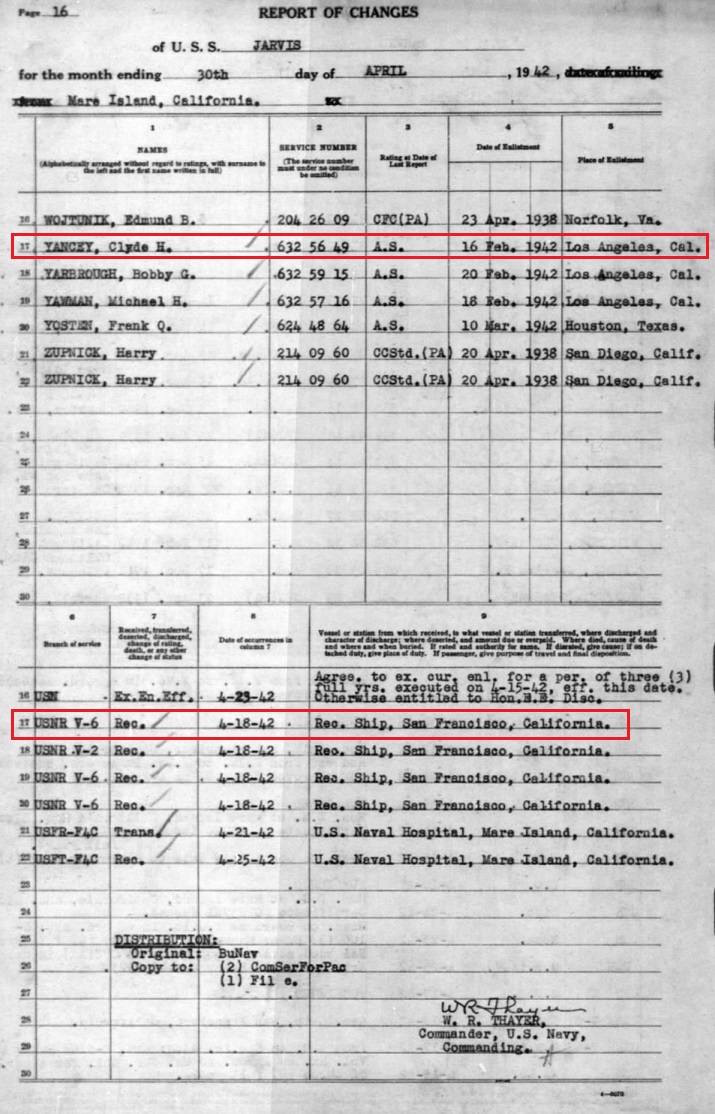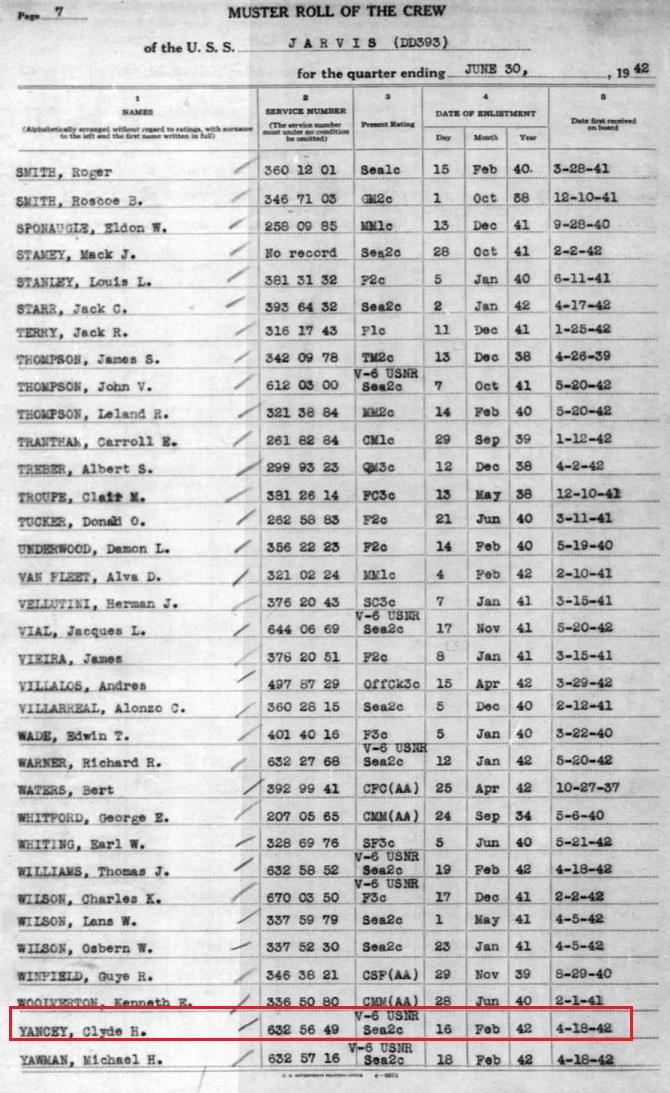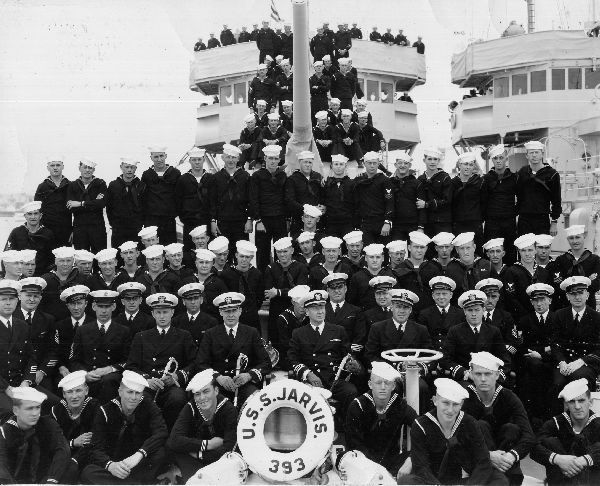Clyde Herman Yancey
1924 - 1945

Clyde Herman Yancey was born 31 Oct 1921 in Sebastian County, Ar to
Henry Lee & Johanna Annie Gist Yancy. His father Henry being
from Mansfield and mother Johanna from Huntington.
Clyde enlisted in the Navy on Feb 16, 1942 in Los Angeles, Ca.
Seaman Second Class Yancey is listed as "missing" Near Savo Island, Pacific on
12 Jul 1945 and that was his last known status. S2c Yancey has a memorial at
Fort William Mckinley, Manila, Capital District, National Capital Region, Philippines.
Name: Clyde H Yancey
Inducted From: California
Rank: Seaman Second Class
Combat Organization: United States Navy Reserve
Death Date: Jul 12 1945
Monument: Fort William Mckinley, Manila, the Philippines
Last Known Status: Missing
U.S. Awards: Purple Heart Medal
Name: S2 Clyde H Yancey
Death Date: 12 Jul 1945
Cemetery: Manila American Cemetery and Memorial
Burial or Cremation Place: Manila, Capital District, National Capital Region, Philippines
American Battle Monuments Commission
Full Name Clyde H Yancey
State of Residence California
Death 12-Jul-45
Death Date 12 Jul 1945
Buried Missing in Action or Buried at Sea Tablets of the Missing at Manila American Cemetery Manila, Philippines
Memorial Location
Missing in Action or Buried at Sea
Memorial Cemetery Tablets of the Missing at Manila American Cemetery
Memorial Country Manila, Philippines
Rank Seaman, Second Class, U.S. Navy
Service Number 6325649
Regiment United States Naval Reserve
Conflict Period World War II
Awards Purple Heart
Defense POW/MIA Accounting Agency, Unaccounted-for Remains
Full Name Yancey, Clyde H
Series Title Unaccounted-for Remains, Group A, 1941-1975
Residence Place California
Conflict World War II
Death Date 9 Aug 1942
Death Country Solomon Islands
Branch United States Navy
Mia Place Solomon Islands
Mia Place Alias Solomon Islands
USS Jarvis
Jarvis departed Pearl Harbor on 5 February 1942 to escort a convoy to Brisbane, Australia. Following her return on 27 March,
the destroyer sailed on 8 April for San Francisco to undergo alterations with the other ships of DesRon Four. She returned to Pearl
Harbor on 18 May escorting 13 ships and proceeded five days later via Fiji to Sydney, Australia. Arriving on 18 June, Jarvis commenced
convoy escort and ASW patrols from Australia to New Caledonia, continuing with this duty until she was tasked to participate in the
invasion of Guadalcanal.
Guadalcanal campaign
Sailing from Sydney on 14 July, Jarvis arrived in Wellington, New Zealand, on 19 July to join Task Force 62. The task force sailed on 22 July
for the Solomons. After conducting rehearsal landings in the Fiji Islands from 28 to 30 July, the invasion force of 84 ships and 20,000 Marines
steamed for Guadalcanal on 31 July. Protected from Japanese search planes by rain and heavy mist, the force arrived off the landing beaches at
dawn on 7 August.
Following naval and air bombardment of enemy defenses, the first amphibious operation of the war commenced at 0650.
Jarvis patrolled as part of the protective screen while Marines established a beachhead. As landing operations progressed,
the Allied forces expected the Japanese to strike at the transports with land-based aircraft. However, during the two
attacks that occurred that afternoon, the American ships sustained only minor damage and claimed to have destroyed 14
attacking aircraft.
Following a night patrol off the southern end of Savo Island, Jarvis returned to Lunga Point to screen the unloading transports.
The warning of an impending air attack suspended these operations and the transports and their protective screen deployed in the
body of water between Guadalcanal and Florida Island, soon to be called "Ironbottom Sound". When enemy torpedo bombers appeared
around noon on 8 August, they met by heavy anti-aircraft fire. Only 9 of the 26 planes penetrated the defensive fire, but they set
the attack transport George F. Elliott on fire and torpedoed Jarvis as she maneuvered between the heavy cruiser Vincennes. Although
anti-aircraft fire destroyed the aircraft, its torpedo exploded against Jarvis' starboard side near the forward fireroom, stopping
her dead in the water and killing 14 crewmen. Her crew jettisoned the port torpedoes and brought the fires under control. The
destroyer Dewey towed her to shallow anchorage off Lunga Point and after the attack, she crossed to Tulagi, where she transferred
her seven wounded and conducted temporary repairs.
Despite a 50-foot (15 m) gash in her side, she was considered seaworthy and ordered to proceed under cover of darkness to Efate,
New Hebrides, escorted by the destroyer minesweeper USS Hovey (DMS-11). Unaware of this order as her radios had been disabled,
her commanding officer, Lt. Comdr. William W. Graham Jr, decided to steam to Sydney, Australia, for repairs from the destroyer
tender Dobbin. Unnoticed by her own ships, Jarvis departed Tulagi at midnight on 9 August and moved slowly westward between
Savo Island and Cape Esperance. At 0134 she passed 3,000 yards (2,743 m) northward of Rear Admiral Mikawa's attacking cruiser
force, as they commenced the Battle of Savo Island. Mistaking her for a cruiser of the New Zealand Achilles class, the destroyer
Yūnagi briefly engaged her with gunfire and torpedoes, without effect.
The destroyer, continuing to retire westward, had little speed, no radio communications, and few operational guns but she refused
aid from the destroyer Blue upon being sighted at 0325. After daybreak a Saratoga-based scout plane sighted her 40 miles off
Guadalcanal, trailing fuel oil and down by the bow.
Loss of Jarvis
The Japanese, still mistaking Jarvis for an escaping cruiser, dispatched 31 planes from Rabaul to search out and destroy her.
Once discovered, the badly damaged destroyer was no match for bombers raking the ship with bullets and torpedoes. According to
Japanese records, Jarvis "split and sank" at 1300 on 9 August. None of her 233 remaining crew survived.
Jarvis received three battle stars for World War II service.
~~~~~~~~~~~~~~~~~~~~~~~~~~~~~~~~~~~~~~~~~~~~~~~~
Buried at Sea Tablets of the Missing at Manila American Cemetery Manila, Philippines





|
|
|
|